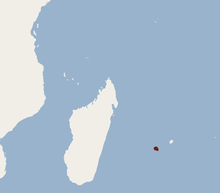Mormopterus francoismoutoui
Mormopterus francoismoutoui is a species of free-tailed bat that is endemic to the island of Réunion, which is east of Madagascar.[1]
| Mormopterus francoismoutoui | |
|---|---|
| Scientific classification | |
| Kingdom: | Animalia |
| Phylum: | Chordata |
| Class: | Mammalia |
| Order: | Chiroptera |
| Family: | Molossidae |
| Genus: | Mormopterus |
| Species: | M. francoismoutoui |
| Binomial name | |
| Mormopterus francoismoutoui Goodman, Jansen van Vuuren, Ratrimomanarivo, Probst & Bowie, 2008 | |
 | |
Taxonomy
M. francoismoutoui was described as a new species in 2008. The holotype had been collected in 2006 in the commune of La Possession on the island of Réunion. The eponym for the species name "francoismoutoui " is biologist Francois Moutou.[2]
Description
M. francoismoutoui is a relatively large member of its genus, with a forearm length ranging from 38–42 mm (1.5–1.7 in). Adult body mass ranges from 6.0–8.2 g (0.21–0.29 oz). It has a dental formula of 1.1.1.33.1.2.3 for a total of 30 teeth.[2]
Range and habitat
M. francoismoutoui is found only on the island of Réunion. It has been recorded throughout the island at various localities ranging from 0–2,000 m (0–6,562 ft) above sea level.[2][1]
Conservation
As of 2017, M. francoismoutoui is evaluated as a least-concern species by the IUCN—its lowest conservation priority. It meets the criteria for this classification because it has numerous large roosts across the island. Additionally, no threats to the species are known.[1]
References
- Goodman, S. (2017). "Mormopterus francoismoutoui". IUCN Red List of Threatened Species. 2017: e.T71727235A71727484. doi:10.2305/IUCN.UK.2017-2.RLTS.T71727235A71727484.en.
- Goodman, S. M.; Van Vuuren, B. Jansen; Ratrimomanarivo, F.; Probst, J-M.; Bowie, R. C K. (2008). "Specific status of populations in the Mascarene Islands referred to Mormopterus acetabulosus (Chiroptera: Molossidae), with description of a new species". Journal of Mammalogy. 89 (5): 1316–1327. doi:10.1644/07-MAMM-A-232.1.
